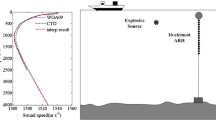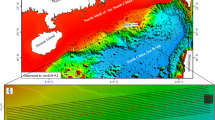Abstract
The parameters of deep ocean sediments are relevant for accurately predicting the sound field; however, it is difficult to measure the parameters in situ. Most inversion methods used in shallow water are inapplicable in the deep ocean because of the considerable differences in propagation characteristics. At present, no method for simultaneously obtaining sound speed, density, and attenuation that considers the sensitivity of sediment parameters is yet available. This study proposes a two-step inversion of geoacoustic parameters in the deep ocean. On the basis of the half-space model, the decline tendency of bottom reverberation level with travel time is used for the inversion of sound speed and density, whereas transmission loss is used for inversion of attenuation. Inversion results can be practical for acoustic applications when this method is used. Experimental data from the South China Sea in the summer of 2014 are processed during the inversion process. The sediment parameters obtained from the inversion process are close to the laboratory-measured sampling values and may be used to predict the sound field in various applications, such as in transmission loss in the deep ocean.













Similar content being viewed by others
References
Prior, M.K., Harrison, C.H.: Estimation of seabed reflection loss properties from direct blast pulse shape. J. Acoust. Soc. Am. 116(3), 1341–1344 (2004)
Yang, K., Ma, Y.: A geoacoustic inversion method based on bottom reflection signals. Acta Phys. Sin. 58(3), 1798–1805 (2009)
Guo, X., Yang, K., Ma, Y., Yang, Q.: Geoacoustic inversion based on modal dispersion curve for range-dependent environment. Chin. Phys. Lett. 32(12), 74–77 (2015)
Guo, X., Yang, K., Ma, Y.: A far distance wideband geoacoustic parameter inversion method based on a modal dispersion curve. Acta Phys. Sin. 64(17), 174302-1–174302-9 (2015)
Gerstoft, P., Ellis, D.D.: Application of multifrequency inversion methods to obtain seabed properties from broadband reverberation data. J. Acoust. Soc. Am. 100(4), 2665–2665 (1996)
Zhou, J., Guan, D., Shang, E., Luo, E.: Long-range reverberation and bottom scattering strength in shallow water. Chin. J. Acoust. 6(1), 151–153 (1982)
Yang, K., Ma, Y., Sun, C., Miller, J.H., Potty, G.R.: Multistep matched-field inversion for broad-band data from ASIAEX2001. IEEE J. Ocean. Eng. 29(4), 964–972 (2005)
Yang, K., Chapman, N.R., Ma, Y.: Estimating parameter uncertainties in matched field inversion by a neighborhood approximation algorithm. J. Acoust. Soc. Am. 121(2), 833–843 (2007)
Chapman, N.R.: Modeling ocean-bottom reflection loss measurements with the plane-wave reflection coefficient. J. Acoust. Soc. Am. 73(5), 1601–1607 (1983)
Dong, H., Chapman, N.R., Hannay, D.E., Dosso, S.E.: Estimation of seismic velocities of upper oceanic crust from ocean bottom reflection loss data. J. Acoust. Soc. Am. 127(4), 2182–2192 (2010)
Yang, K., Xiao, P., Duan, R., Ma, Y.: Bayesian inversion for geoacoustic parameters from ocean bottom reflection loss. J. Comput. Acoust. 25(3), 1750019-1–1750019-17 (2017)
Shuanglin, W., Li, Z., Qin, J.: Geoacoustic inversion for bottom parameters in the deep-water area of the South China Sea. Chin. Phys. Lett. 32(12), 70–73 (2015)
Guo, X., Yang, K., Ma, Y.: Geoacoustic inversion for bottom parameters via Bayesian theory in deep ocean. Chin. Phys. Lett. 34(03), 68–72 (2017)
Ellis, D.D., Crowe, D.V.: Bistatic reverberation calculations using a three-dimensional scattering function. J. Acoust. Soc. Am. 89(5), 2207–2214 (1991)
Jackson, D.R., Winebrenner, D.P., Ishimaru, A.: Application of the composite roughness model to high-frequency bottom backscattering. J. Acoust. Soc. Am. 79(5), 1410–1422 (1986)
Jackson, D.R., Briggs, K.B.: High-frequency bottom backscattering: roughness versus sediment volume scattering. J. Acoust. Soc. Am. 92(92), 962–977 (1992)
Williams, K.L., Jackson, D.R.: Bistatic bottom scattering: model, experiments, and model/data comparison. J. Acoust. Soc. Am. 103(1), 169–181 (1997)
Porter, M.B.: The Bellhop Manual and User’s Guide: Preliminary Draft, pp. 17–20. Heat, Light, and Sound Research, Inc, LaJolla (2011)
Argyris, J.H., Scharpf, D.W.: Finite elements in time and space. Nucl. Eng. Des. 10(4), 456–464 (1969)
Harrsion, C.H.: Fast bistatic signal-to-reverberation-ratio calculation. J. Comput. Acoust. 13(02), 317–340 (2008)
Locarnini, R.A., Mishonov, A.V., Antonov, J.I., Boyer, T.P., Garcia, H.E., Baranova, O.K., Zweng, M.M., Johnson, D.R.: World Ocean Altas 2009 Volume 1: Temperature. U.S. Government Printing Office, Washington DC (2009)
Antonov, J.I., Seidov, D., Boyer, T.P., Locarnini, R.A., Mishonov, A.V., Garcia, H.E.: World Ocean Altas 2009 Volume 1: Salinity. U.S. Government Printing Office, Washington DC (2009)
Zhang, X., Cheng, C., Liu, Y.: Acoustic propagation effect caused by subtropical mode water of northwestern Pacific. Acta Oceanol. Sin. 36(9), 94–102 (2014)
Hamilton, E.L., Bachman, R.T.: Sound velocity and related properties of marine sediments. J. Acoust. Soc. Am. 72(6), 1891–1904 (1982)
Holland, J.H.: Adaptation in natural and artificial systems: an introductory analysis with applications to biology, control, and artificial intelligence. Q. Rev. Biol. 6(2), 126–137 (1992)
Kennedy, J., Eberhart, R.: Particle swarm optimization. IEEE Int. Conf. Neural Netw. 4(8), 1942–1948 (1995)
Langdon, W.B., Poli, R.: Evolving problems to learn about particle swarm optimizers and other search algorithms. IEEE Trans. Evol. Comput. 11(5), 561–578 (2007)
Ling, S.H., Iu, H.H.C., Leung, F.H.F., Chan, K.Y.: Improved hybrid particle swarm optimized wavelet neural network for modeling the development of fluid dispensing for electronic packaging. IEEE Trans. Industr. Electron. 55(9), 3447–3460 (2008)
Hamilton, E.L.: Variations of density and porosity with depth in deep-sea sediments. J. Sediment. Res. 46(2), 280–300 (1976)
Acknowledgements
We thank all the researchers and staff for their help in the research program of the South China Sea in summer 2014. We also appreciate the reviewer for the comments and suggestions, which are highly insightful and very helpful for improving this manuscript.
Author information
Authors and Affiliations
Corresponding author
Additional information
Project supported by the National Natural Science Foundation of China (Grant No. 41476028).
Rights and permissions
About this article
Cite this article
Yang, K., Xu, L., Yang, Q. et al. Two-Step Inversion of Geoacoustic Parameters with Bottom Reverberation and Transmission Loss in the Deep Ocean. Acoust Aust 46, 131–142 (2018). https://doi.org/10.1007/s40857-018-0130-2
Received:
Accepted:
Published:
Issue Date:
DOI: https://doi.org/10.1007/s40857-018-0130-2




